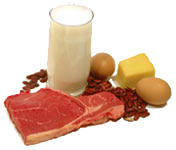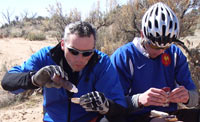Sports Nutrition For Cycling!
 |
Even if you ride mainly for fun you probably know how important eating and drinking are in order to keep pedaling. And, if you're a weekend warrior or racer, you've likely experienced how quickly you can run out of energy on hilly, demanding and/or long rides if you don't stay hydrated and fed—and how badly it can make you feel. Eating and eating right is that important. Which is why today's vast assortment of energy drinks and foods is such a wonderful thing, and why we keep them in stock and carry and consume them ourselves on all our rides, too. However, there are so many options in sports-nutrition products these days that choosing the right ones to purchase and eat gets confusing. To help, we offer this basic guide. First, keep in mind that sports drinks, energy bars, gels and chews all keep you riding efficiently and ensure that you can achieve your goals by replenishing what you use while riding, which includes water, energy and minerals. And, how much you burn and need to replace depends on many factors, including your level of fitness, your effort, the course you're riding, the weather and more. We've broken down the components of many sports foods to help reveal some of the mysteries behind sports nutrition and help you decide which are right for you and how to best use them. Tip: If you have some energy drinks or food handy you can learn by reading the labels as we go over the details of similar items below. Water On rides less than 90-minutes long, you can get by drinking good-old plain H2O, which is usually all you need to stay hydrated. Ideally, you'll replace the water you're losing through sweat, and no faster than your body can absorb it because too  much water can leave you feeling bloated. Studies have shown that the rate of water loss through sweating is nearly the same as the body's rate of water absorption, about one to three quarts per hour. That's the same as one to two small water bottles of water you're losing! Obviously this amount depends on several factors including your adaptation to the environment and how hard you're riding. much water can leave you feeling bloated. Studies have shown that the rate of water loss through sweating is nearly the same as the body's rate of water absorption, about one to three quarts per hour. That's the same as one to two small water bottles of water you're losing! Obviously this amount depends on several factors including your adaptation to the environment and how hard you're riding.An easy way to check your hydration needs is to weigh yourself just before and right after your rides. Every pound of weight you've lost represents 16 ounces of water that didn't get replaced. If you've gained weight, then you're drinking too much water. Tip: For best results, try sipping every 15 minutes instead of waiting until you feel really thirsty and chugging it down, because drinking too much too fast can lead to a queasy stomach and you don't want that. Carbohydrates While you do burn some fat cycling and during other types of aerobic exercise, your body can actually demand more energy than it can get from burning fat, which is where carbohydrates (essentially, sugars), come in. On rides less than 90-minutes long, your body uses the sugar (glycogen) stored in the muscles and liver for the energy to keep you pedaling. These stores of energy are more readily available to your muscles than fat and than anything digesting in your stomach, too. They are also the limiting factors to the amount of energy you have on the ride. In fact, if you have ever used up these reserves you may have experienced the lightheadedness, cold sweats and disorientation that come with it, an uncomfortable ride-ruining feeling that experienced cyclists call "bonking." Tip: To prevent this, carry and consume alternate sources of sugar (energy foods and drinks) so that you can top off your stored glycogen and never run out. It's important to understand that carbohydrates are made up of different sugars, which then become your primary source of fuel when you've burned up your glycogen stores. Sports drinks, bars, gels, and chews contain different amounts and combinations of sugars to keep you energized for the entire ride. Your body breaks down all of these sugars to create muscle energy and this process starts as soon as the energy food is in your mouth. However, everyone digests and absorbs various sugars differently, so don't choose a carbohydrate source just because your friend recommends it. Tip: Be sure to experiment with different foods to find out which ones work best for you. Here's an overview:  Glucose: Also known as dextrose or blood sugar, this is the basic form of sugar that your body uses for energy. All other forms of sugar are broken down through digestion into glucose to be absorbed into the bloodstream and used by your muscles. Glucose is only mildly sweet and is more costly to produce than other sugars. Glucose: Also known as dextrose or blood sugar, this is the basic form of sugar that your body uses for energy. All other forms of sugar are broken down through digestion into glucose to be absorbed into the bloodstream and used by your muscles. Glucose is only mildly sweet and is more costly to produce than other sugars.Maltose: Commonly listed as maltodextrin, this sugar is two glucose molecules bonded together. It's easily broken down and readily absorbed into the bloodstream. Maltose is sweeter than glucose and less costly, too. Fructose: The sugar naturally found in fruits and honey, fructose is broken down into glucose by your liver. High fructose corn syrup (HFCS) is a mix of 55% fructose and 45% glucose and is both very sweet and inexpensive to make. Sucrose: You probably know this one better as table sugar. It's made of a glucose and fructose molecule which must be broken down through digestion before it can be used by your body. It is almost as sweet as HFCS and costs only a little more. Sugar substitutes: There are both natural and artificial sugar substitutes. Natural ones, including sorbitol and xylitol, have fewer calories than other sugars and are found in fruits and vegetables. Consuming large quantities of these sweeteners can cause gastrointestinal distress. Artificial sweeteners including saccharin, aspartame and sucralose are synthesized in a lab. While these taste sweet like sugar, they are not recognized by your body as fuel and do nothing to keep you energized on a ride. Tip: To figure out which sugars are best, experiment with different kinds of foods reading the ingredients list on the label and you'll learn which foods work best for you and which ones you should avoid. If you have a sensitive stomach, look for products with easily digestible carbohydrates to use while you're riding, such as glucose and maltose. A rule of thumb is to eat 30 to 60 grams of carbohydrate per hour while riding whether you are training or participating in an event. Be careful though because the body can only process about 250 calories per hour and eating or drinking more than that can upset your stomach. So, be sure to read the labels to find out how many calories per serving are in the foods and drinks you're consuming as well as how many servings they provide.  Electrolytes |

 Protein helps repair and maintain your muscles and is an important part of post-ride recovery. If you don't provide it with another source of energy while you're riding, your body will break down muscle protein into glucose once you've used up your stores of glycogen. So, certain makers are now including some protein in their energy foods for use during exercise to help prevent muscle breakdown. Protein, however, takes longer to digest than carbohydrates and is most important after your ride.
Protein helps repair and maintain your muscles and is an important part of post-ride recovery. If you don't provide it with another source of energy while you're riding, your body will break down muscle protein into glucose once you've used up your stores of glycogen. So, certain makers are now including some protein in their energy foods for use during exercise to help prevent muscle breakdown. Protein, however, takes longer to digest than carbohydrates and is most important after your ride. Some cyclists can't get going without their daily cup of Joe, and others swear by its energy-enhancing abilities so today there are plenty of drinks and energy foods that contain it. Caffeine gives you a boost by triggering the "fight or flight" response in your brain, making your heart beat faster and increasing the blood flow to your brain and muscles.
Some cyclists can't get going without their daily cup of Joe, and others swear by its energy-enhancing abilities so today there are plenty of drinks and energy foods that contain it. Caffeine gives you a boost by triggering the "fight or flight" response in your brain, making your heart beat faster and increasing the blood flow to your brain and muscles. your electrolytes are low, for example.
your electrolytes are low, for example.